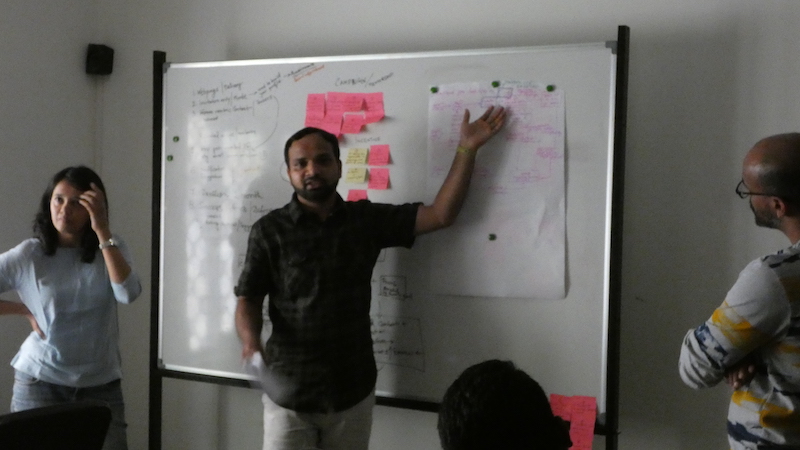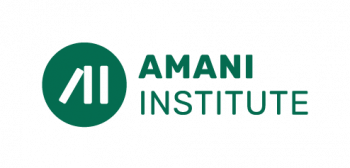Tushar Gaware is the Co-founder and Lead (Central Production and Quality) at S4S Technologies, a food preservation company that invents new food processing machines and creates a sustainable supply of processed food products. S4S is one of the participating organizations of Amani Institute’s Leadership for Growth program. While doing the program, Tushar’s design for a modified vegetable cutting machine saved his company approximately 2.9 million rupees (approx 38,000 USD). He also designed and operationalised the first-ever quality control process in this company, and reduced customer complaints to zero in a span of 3 months. Tushar reflects on this journey so far.
Describe your overall experience of the program. What were your most significant takeaways?
I’ve always been a shy and reserved person. Despite being aware of my abilities, I would always find it hard to express my thoughts and ideas openly with my team and manager. The program helped me gradually overcome this inhibition in a safe, non-judgmental space and this has made a huge difference for my role at S4S technologies. I’m a lot more confident about expressing my views. My line manager (our CEO) appreciates me for not only identifying problems but also for proposing solutions and alternate approaches to them as well. In a small and growing business like ours, it is important for managers to be outspoken so that problems and solutions are discussed and acted upon at the right time. As a team manager, it was also important for me to model this behaviour to my team members. For me, this was a very personal milestone to reach because I’ve had a long struggle with expressing myself boldly and confidently.
Overall, the Leadership for Growth program at Amani Institute has helped develop a much more holistic view of who I am, how I relate to others and also my role as both a manager of projects and a leader of people. This distinction has become very clear and I recognize the importance of wearing both these hats. It has helped me lay the foundation for developing leadership skills and a culture of innovation within my team and across the organization.
What motivated you to join the Leadership for Growth program? And what goals did you set for yourself at the start of the 5-month journey?
It wasn’t until recently that we started defining Key Result Areas (KRAs) for each team member in our organization. In September, my manager defined a set of KRAs for me and asked me to define my personal development goals. I set myself five goals:
- Build a team and delegate work effectively
- Enhance my risk-taking ability and deal with the downsides of risk
- Learn to manage chaotic situations and unplanned work
- Build networks and initiate conversations
- Learn tools for effective management
I drafted these goals two months before joining the program. And when my manager nominated me for Leadership for Growth, I looked at the curriculum and found that it was designed exactly for the KRAs and personal development goals I had set for myself.
What are the visible improvements you have seen in your performance after completing the program?
The first big improvement is my ability to delegate work. As one of the co-founders of the organization, I need to be able to switch between being an effective team and project manager as well as an inspiring leader. The module of ‘Leading Others’ helped me learn some guiding principles and tools for delegating work effectively. Over these five months, I’ve been able to practice it with my team and incrementally improve my delegation skills. I don’t feel the urge to handle all tasks by myself anymore and am much more at ease now allowing my team to take on new responsibilities. In addition to this, I’d say I’ve been able to achieve at least 60 percent of my remaining KRAs and goals within the past six months.
Which part of the Leadership for Growth program did you find most relevant and useful?
The first module of ‘Leading Self’ was a useful starting point for me. The concepts and activities mirrored to me some of my current ways of working. I was able to witness common triggers to my behaviors and actions in various situations and relate them to my workplace. Becoming aware of my core strengths and weaknesses was useful in understanding where I can and cannot make an impact in my organization.
From the module on ‘Leading Others’, I’ve been able to give my team members a chance to handle responsibilities and take their own decisions. This has also allowed me to create more time for strategy and planning work that I was unable to make time for in the past.
Finally, the Business Innovation Project was one of the most meaningful elements of the entire program for me. Working on a real business challenge and applying the tools and skills to innovate and solve it was one of the most engaging experiences. We’ve seen tremendous results for the organization because of the Business Innovation Project.
Could you tell us more about it? What was the challenge you were working on? And what was your innovative solution?
Historically, one of our biggest production challenges has been to ensure that even minute defects or variations in the quality of our raw materials don’t affect the entire batch of processed foods. Sometimes these changes in consistency are very hard to spot. As a reputed food preservation company how do we mitigate these risks and ensure that our customers don’t have to report any such occurrences to us?
One of the most important skills I learned in the program was how to define and understand a problem before trying to solve it. This helped me immensely while trying to explore this big question. I used problem framing tools and frameworks I learned in the program to help me dig deeper. A big insight from the root-cause analysis I conducted was that our company didn’t have a quality control process in place. Production and Sales were running as independent processes and there was no mechanism to check and verify our materials before they were supplied.
As a first step, I defined a list of criteria that our procurement team could use for accepting and rejecting materials. In addition, I also asked our customers to give us their list of quality specifications that our delivery team could use to verify the quality of materials before supplying to our clients.
Now, even a bigger challenge was to communicate with all my internal stakeholders – the procurement team and the vendors – and bring them on board. My idea disrupted their existing ways of working and I had to ensure they saw value in embracing this change before I could even begin testing the idea. For the procurement team, a new quality control process meant additional tasks and accountability. My vendors were upset whenever we returned a batch of materials. I had to convince them about the long term benefits of keeping clients happy and how that could mean bigger orders in the future if we supplied high-quality materials. This process taught me that no matter how brilliant my idea is, if my internal stakeholders were not on board with me, I wouldn’t succeed in implementing it.
How did you manage to convince your internal stakeholders?
The workshop on rapid prototyping really helped me. I introduced the new quality control process and ran quick prototypes for all materials being procured and supplied. Within the first month, quality complaints had reduced to zero. We continued the experiments for the second month and achieved a zero quality complaint record. We made a few iterations to the process and formally implemented it across the organization. Within the third month of introducing the new quality control process, we received a big order for 30 metric tons of ginger bits – all thanks to the new process.
You also conducted another prototype that saved your organization 29 lakh rupees (approximately USD 38,000). Tell us the story.
We work with women micro-entrepreneurs for processing our food products. We provide them with a set of machines which includes a dryer and a cutting machine that they can operate from their homes.
In January, we bagged an order for processing a large batch of turmeric. Our operations team approached the CEO and placed a request for 200 cutting machines within 15 days. The machines had to be installed at the micro-entrepreneurs’ homes before the raw materials arrived. The cost of each machine was estimated at INR 27,000 (approx USD 355), for a total of INR 54,00,000 (approx. USD 71,000).
Our CEO approached me for advice on whether we should release the purchase order or put it on hold. To place it hold, we needed a reliable alternative which we didn’t have yet. He gave me, as well as our design team, a week to come up with a solution.
Here’s where I was able to again use the rapid prototyping tools and skills I had learnt in the program. Within the first two days, I researched various cutting and drying machines and came up with a design to combine the two functions into one machine. On day 3, I explained the design to our CEO. He was very happy to see the design but also wanted to see some proof of how it will work. On day 4, within a span of 12 hours, I created a functional prototype of the new machine (using inexpensive materials like sunboard and PVC pipes) and demonstrated it to our CEO. My new design had brought down the unit cost of each machine from INR 27,000 (approx USD 355) to INR 12,500 ( approx. USD 165) – that’s a 50 percent reduction. The total estimated savings on 200 machines were INR 29,00,000 (approx. USD 38,000).
We are currently inviting applications for our next cohort which starts April 23rd, 2021. Apply here.





